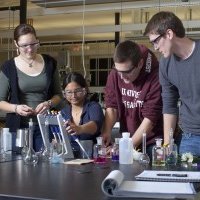Submitted by auerbach on

Last year David Brooks bemoaned the clean tech industry as a “Sad Green Story” in the New York Times. In 2006 Ken Robinson’s TED talk claimed that today’s educational systems are killing creativity. Do these condemnations – separated by topic, time, and place – have anything to do with each other? I claim they have everything to do with each other. Science education has become so thoroughly divorced from the society it is meant to serve, it’s no wonder that the creativity and collaboration needed to bolster a new clean tech industry is the rare exception rather than the rule. Here’s an example:
We all have heard that cellulosic biofuels offer a renewable and ideally carbon-neutral source of liquid transportation fuels that fit into our present infrastructure. So where are these biofuels today? Well, they’re still pretty expensive given the need to grow plant biomass, to harvest and pretreat the fibrous plant matter, and to efficiently refine carbohydrates into high-octane fuels. Solving this multi-faceted technical problem requires synergistic collaboration among agronomists, plant biologists, mechanical and chemical engineers, and organic chemists. What’s more, this team needs to understand the technical problem in the context of political and economic realities, and then communicate the problem’s solution in terms that compel action by both the public and policy makers alike.
![]() Where do science and engineering students learn to do all this in college? The answer prior to 2011 was simple: nowhere. We’re simply not teaching our future scientists and engineers how to solve the big problems of their time. Not until now, that is.
Where do science and engineering students learn to do all this in college? The answer prior to 2011 was simple: nowhere. We’re simply not teaching our future scientists and engineers how to solve the big problems of their time. Not until now, that is.
Not until the launch of the Integrated Concentration in Science (iCons) Program at UMass Amherst. Here we recruit technical students from all corners of campus, set them in diverse teams, and challenge them to design solutions for real-world problems of global significance. We start by opening up the newspaper – the list of today’s problems – and not any textbook, which slices and dices complex challenges into disciplinary dogma. How do college students respond to such humongous problems? See for yourself in this video. You have to admit that these students are totally engaged in their work, and ready to take on the world!
In the end, iCons students learn how to identify key technical challenges embedded in society’s problems. Whether they’re studying new organic solar cells, next-generation fuel cells, or bio-based energy sources to name a few the student-driven topics, iCons students learn the arts of synergistic team work, compelling communication, and technical leadership. In short, they gain the attitudes, knowledge, and skills needed to solve the inherently multi-faceted problems facing our world.
![]() After reading this I bet you’re thinking, “Ok, it’s obvious this is the way we should be teaching science and engineering students to make a difference. So why isn’t everybody doing this? Why is iCons-like education only happening at UMass Amherst?” Well, that’s a good question! It turns out that how you teach (pedagogy) is just as important (or more so) than what you teach (curriculum). And we’ve discovered that teaching iCons requires faculty to become a “guide on the side” and no longer the “sage on the stage,” allowing students to pose their own questions and design theirown investigations, practicing the art of science leadership – just as Ken Robinson demands. This role reversal takes faculty with courage, and we are blessed with many courageous faculty members at UMass Amherst.
After reading this I bet you’re thinking, “Ok, it’s obvious this is the way we should be teaching science and engineering students to make a difference. So why isn’t everybody doing this? Why is iCons-like education only happening at UMass Amherst?” Well, that’s a good question! It turns out that how you teach (pedagogy) is just as important (or more so) than what you teach (curriculum). And we’ve discovered that teaching iCons requires faculty to become a “guide on the side” and no longer the “sage on the stage,” allowing students to pose their own questions and design theirown investigations, practicing the art of science leadership – just as Ken Robinson demands. This role reversal takes faculty with courage, and we are blessed with many courageous faculty members at UMass Amherst.
Will iCons students be in high demand by grad schools and the private sector? You betcha! How long will it take for students from the iCons Program, and the programs inspired by it, to convert David Brooks’ green story from sad to glad? Only time will tell. But we are finally producing science students who are built to innovate, dreaming of sustainable solutions that will make even Ken Robinson proud.
Prof. Auerbach's blog post was originally posted on ChEnected.
Stay Connected